Yellow Sapphire has become a favorite in jewelry because it is available in so many color nuances, ranging from a light lemon yellow to a fully saturated vivid yellow to a deep orangey-yellow. Yellow sapphire also has a special place in Vedic astrology, where pukhraj is one of the 9 sacred gems.
Sapphire is one of the most important of all the loose colored gemstones and comes in a wide variety of colors: blue, pink, yellow, green, purple, orange, padparadscha, blue green, lemon yellow, color change, and black color. With a hardness of 9 on the Moh's scale, loose cut sapphires are extremely hard tough and durable, they are suitable for use in any kind of jewelry. Sapphire of all colors have become especially popular for engagement rings, since sapphire is durable enough to wear every day.
The prices and value of yellow sapphire vary depending on the size, quality and treatment of the individual gemstone. Unheated yellow sapphires with good color saturation and excellent clarity are the rarest and most valuable, especially in larger sizes, and much sought after by gem collectors. Most yellow sapphires have been heat treated to improve the color and clarity. In addition, many yellow sapphires in the market have been heat treated with beryllium, in a process known as lattice diffusion. This process produces vivid yellows and oranges.
Why Buy Loose Gemstones Instead of Pre-Set Jewelry?
There are many reasons, but basically it boils down to value and choice.
When buying your gemstone loose instead of a pre-set stone, you can be sure you are getting the best value for your money. Loose gemstones are less expensive, a better value, and you can really see what you are paying for. The most important part of getting the right price and finding the best value is to first see what you're getting. A jewelry setting will hide the inclusions inside a gem, and can deepen or brighten its color. With a loose stone you can much more easily inspect the gem and see it for what it really is. In this way you can get a better idea of its true worth and be sure you are paying a fair price.
The second advantage of buying a loose gemstone is choice. You are free to pick the exact color, cut, shape and variety of the stone for the setting of your dreams, be it yellow gold, white gold, platinum or silver; prong set or bezel set. You can experience the joy of creating your very own, one-of-a-kind jewelry design. Choose from a variety of jewelry settings and styles to create a completely original presentation that will perfectly suit your individual gemstone and will be as unique as you are!
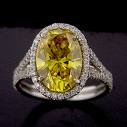
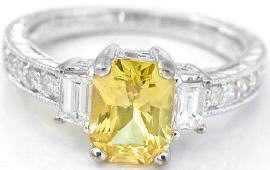
| Origin | Madagascar, Thailand, Sri Lanka, Ceylon, Burma, Australia, India, Kenya, Tanzania, U.S.A. |
|---|---|
| Color | Yellow, light lemon to dark yellow, Burma yellow, Ceylon yellow, orange-yellow |
| Refractive Index | 1.759-1.778 |
| Chemical Composition | AL2 O3 |
| Hardness | 9 |
| Density | 4 |
| Crystal Structure | Trigonal |
| Zodiac Sign | Libra |
| Planet | Venus |
| Month | September |
| Anniversary | 5th and 45th |
Yellow sapphire's attractive color is just one reason for this gemstone's popularity. As with all sapphire, it's also extremely durable, having a hardness of 9 on the Mohs scale. Sapphire has a specific gravity of 4.00, a refractive index of 1.76 - 1.78, and birefringence of 0.008. The refractive index (RI), measured using a refractometer, is an indication of the amount light rays are bent by a mineral. Birefringence is the difference between the minimum and maximum RI. When birefringence is high, light rays reflect off different parts of the back of a stone causing an apparent doubling of the back facets when viewed through the front facet.
The name sapphire comes from the Greek word "sapphirus", meaning "blue". However, sapphire gemstones come in many colors including pink, yellow, orange, green, black, color-change, purple, violet, light blue, and the rare orange-pink Padparadscha sapphire gems.Padparadscha comes from the Sinahalese word meaning "lotus color". Sapphires other than blue, pink, yellow, green and orange sapphire are usually called "natural fancy-color sapphire". Red hues result from traces of chromium. The greater the concentration of oxides the deeper the color. So pink sapphire and ruby are the same gemstone with just different levels of chromium.
Ovals, rounds, cushions and emeralds are the most common cuts for yellow sapphire, due to the typical shape of saphire rough. Other popular sapphire shapes include pears, briolettes, hearts and marquises. Star sapphires are cut into the cabochon shape in order to develop and properly display the star effect. Fibers or fibrous cavities within a star sapphire reflect the light which causes a star to appear within the stone. A six-ray star sapphire has three sets of parallel fibers. Skilled cutters can sometimes create a 12-ray star sapphire but they are rare.
Treatments
Traditional heating is widely used for yellow sapphire and is an accepted enhancement process which can improve the transparency and color of the stones. Techniques range from simply throwing gems into a fire to be cooked, to employing sophisticated electric or gas furnaces at specific pressures and atmospheric conditions. The treatment is permanent and heated stones do not require any special care.
New treatments which are used to produce blue, pink, orange and yellow sapphire stones are more controversial. This new treatment is a heat-diffusion process which is stable and may or may not completely penetrate the stone. The color is achieved through a process which includes the addition of foreign elements to achieve the desired color alteration.
Sosnagems fully discloses any and all treatments to our gemstones.
Today however, there is a new and important source of gem quality sapphires on the market - Madagascar. Madagascar produces sapphires in all the popular colors, including blue, yellow, pink and green. The quality of the best Madagascar stones is outstanding and they are now as highly regarded as Ceylon sapphire in the international market.
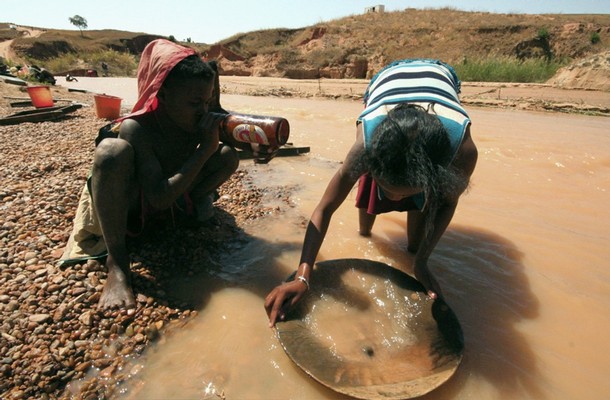
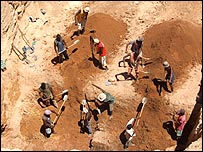

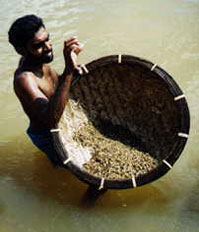
USA
Rubies can be found in the U.S. in the Cowee Creek District, Macon Co., North Carolina. A few scattered finds were reported in Sparta and Ogdensburg, Sussex Co., New Jersey.
The production of gem-quality sapphires in the United States is not new or recent. In 1865, the first U.S. sapphires were found in the gravels of the Missouri River in Lewis and Clark County, Montana. This was followed by subsequent discoveries on Dry Cottonwood Creek in Deer Lodge County in 1889, on Rock Creek in Granite County in 1892, and in Yogo Gulch in Judith Basin County in 1895. Additionally, small amounts of saphire are recovered from Quartz Gulch in Granite County, Pole Creek in Madison County, the Missouri River in Chouteau County, and Brown's Gulch in Silver Bow County. Furthermore, corundum crystals, from which star sapphires have been cut, are found in Beaverhead and Madison Counties. Also, in 1895, the first sapphires were produced from the Cowee Valley in Macon County, North Carolina. But until very recently, with the exception of Yogo Gulch material, the commercial gemstone industry has had limited interest in U.S. sapphires.
Montana.--Mining of Yogo Gulch sapphires began within a year of their discovery in 1895 and continued for 39 years. In 1923, the mine was damaged so badly by rain that it could not economically recover. Other attempts have been made to commercially mine the deposit, but to date, all of these attempts have ended in economic failure.
Yogo's are unique among the world's sapphires. They lack the color zoning so prevalent in other sapphires, their uniform "corn-flower blue" color is natural (not the result of heat-treating), and their clarity is uniformly high. These features rank them among the world's finest saphires. Unfortunately, the rough is both small and flat, wafer-like in shape. The majority of the crystals or pieces of crystals recovered are too small to be cut, most are less than 1 carat and finds of over 2 carats are rare. Reportedly, the largest crystal was a 19 carat stone found in 1910 that was cut into an 8-carat stone. The size of the cut stones greatly restrict the market for Yogo's, they are beautiful, small, very expensive sapphires.
Currently, Yogo sapphires are produced from three sources: Rancor lnc., produces material from the original Yogo Gulch deposit; Vortex Mining produces from a recently discovered extension of the Yogo dike; and material is produced by individuals from privately owned lots in Sapphire Village. The first two producers market only cut stones and finished goods and the third is comprised essentially of hobbyists.
Historically, the amount of sapphires produced from the Missouri River and Rock Creek areas greatly exceeded that from Yogo Gulch. However, the value of the material produced from Yogo, reported to be in excess of $30 million, is significantly greater than that of the combined values of the other areas. This relationship is rapidly changing.
The combination of large volume commercial operations on the Missouri River, and to some extent Rock Creek, plus the advent of successful heat-treating techniques for the material has greatly enhanced the acceptance of these sapphires by the gemstone industry. This enhanced acceptance has resulted in a significant increase in the market for and value of U.S. sapphires. Unconfirmed reports have circulated that a parcel of select 3- to 10-carat material, suitable for heat-treating, was sold for as much as $40,000 per kilogram. A more realistic price for 3- to 10-carat, sorted mine-run material is in the range of $5,000 per kilogram, with many kilograms of mine-run rough selling for $1,000 per kilogram.
The sapphires from the Missouri River gravels in Lewis and Clark County are a mixture of rough and pitted crystals showing well defined faces and completely rounded and smooth-surface highly stream worn pebbles. The majority of the material is pale blue or blue-green, with deep blue stones quite rare. Stones also are found in pastel blue, green, pink, pale red, purple, yellow, and orange. Most of the stones recovered are less than 6.4 millimeters in diameter, but material 6.4 to 12.7 millimeters in diameter are not uncommon. Material greater than 12.7 millimeters in diameter is rare.
Currently there are seven operations on the Missouri River that commercially produce sapphires and/or operate a dig-for-fee area. Not all of these may be active in any one year. It is the author's understanding that one operation, currently inactive, (a self-propelled floating 16-inch suction dredge) is for sale. The mines operate from about the last week of May through the first week of September.
The Rock Creek sapphires are very similar to the sapphires from the Missouri River but differ in the general shape of the crystals. The stones are basically crude hexagonal plates about the same dimension in width and height, with a much higher percentage of the material being well rounded water worn pebbles. There appears to be more of the larger sized (greater than 12.7 millimeters) material. Additionally, it is reported that the Rock Creek material has a greater percentage of stones that can be heat-treated for color enhancement.
During the past several years, there has been only a single producer on Rock Creek. The producer operated both a commercial recovery plant and a fee recovery area. The fee recovery area sold buckets of gravel for washing and also offered, for a predetermined fixed fee, the output of one day's operation of the commercial wash plant. There is work underway which would result in a second, much larger producer, opening an operation on another deposit in the area. If things go as planned, the new operation on Rock Creek would be the largest sapphire producer in Montana.
There are a number of locations between Dillon in Beaverhead County and Ennis in Madison County that produce lavender, grayish-lavender, bluish-gray, and gray hexagonal sapphire crystals that, when cut, produce stones that contain four- or six-ray stars. At least one producer from the Dillon area is currently advertising the availability of this type of material. The remainder of the sapphire deposits in Montana appear to be operated by individual hobbyists.
Mythology
The myths, legends, beliefs, superstitions, traditions and symbolism associated with blue sapphire have been numerous...
Legend has it that the first person to wear Sapphire was Prometheus, the rival of Zeus, who took the gemstone from Cacaus, where he also stole fire from heaven for man.
Known as the "Gem of Heaven", the ancient Persians believed Sapphires were a chip from the pedestal that supported the earth, and that its reflections gave the sky its colors.
Tradition holds that Moses was given the Ten Commandments on tablets of sapphire, making it the most sacred gemstone. Because blue sapphires represent divine favor, they were the gemstone of choice for kings and high priests. The British Crown Jewels are full of large blue sapphires, the symbol of pure and wise rulers.
The guardians of innocence, Sapphires symbolize truth, sincerity and faithfulness, and are thought to bring peace, joy and wisdom to their owners. In ancient times it was believed that when the wearer of a Sapphire faced challenging obstacles, the gem's power enabled them to find the correct solution.
In India it was believed that a Sapphire immersed in water formed an elixir that could cure the bite of scorpions and snakes. Alternatively, if it were worn as a talisman pendant, it would protect the wearer against evil spirits.
The following legend is Burmese in origin and highlights Sapphires‘ connection with faithfulness: “Eons ago Tsun-Kyan-Kse, a golden haired goddess with Sapphire blue eyes, presided lovingly over the temple of Lao-Tsun. Everyday, the temple‘s chief monk Mun-Ha, meditated before the golden goddess accompanied by his devoted companion, a green-eyed cat named Sinh. One day the temple was besieged by a group of terrible outlaws. When they threw Mun-Ha to the floor, Sinh leapt fiercely at the bandits, jumping up on his master‘s chest to protect him. The wrong doers fled screaming in fear, never to return and in gratitude for his courage, the golden goddess awarded Sinh with her Sapphire blue eyes. To this day, Sinh‘s ancestors guard over the temple.” The temple still stands and is populated by Siamese cat‘s with striking blue eyes (typically this breed has green eyes).
For hundreds of years Blue Sapphires were the popular choice for engagement and wedding rings.

